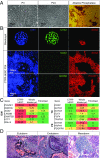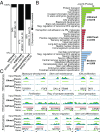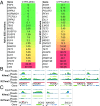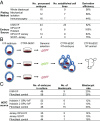Efficient derivation of stable primed pluripotent embryonic stem cells from bovine blastocysts
- PMID: 29440377
- PMCID: PMC5834688
- DOI: 10.1073/pnas.1716161115
Efficient derivation of stable primed pluripotent embryonic stem cells from bovine blastocysts
Abstract
Embryonic stem cells (ESCs) are derived from the inner cell mass of preimplantation blastocysts. From agricultural and biomedical perspectives, the derivation of stable ESCs from domestic ungulates is important for genomic testing and selection, genome engineering, and modeling human diseases. Cattle are one of the most important domestic ungulates that are commonly used for food and bioreactors. To date, however, it remains a challenge to produce stable pluripotent bovine ESC lines. Employing a culture system containing fibroblast growth factor 2 and an inhibitor of the canonical Wnt-signaling pathway, we derived pluripotent bovine ESCs (bESCs) with stable morphology, transcriptome, karyotype, population-doubling time, pluripotency marker gene expression, and epigenetic features. Under this condition bESC lines were efficiently derived (100% in optimal conditions), were established quickly (3-4 wk), and were simple to propagate (by trypsin treatment). When used as donors for nuclear transfer, bESCs produced normal blastocyst rates, thereby opening the possibility for genomic selection, genome editing, and production of cattle with high genetic value.
Keywords: bovine; embryonic stem cell; inner cell mass; pluripotency.
Conflict of interest statement
The authors declare no conflict of interest.
Figures




Comment in
-
Capturing bovine pluripotency.Proc Natl Acad Sci U S A. 2018 Feb 27;115(9):1962-1963. doi: 10.1073/pnas.1800248115. Epub 2018 Feb 14. Proc Natl Acad Sci U S A. 2018. PMID: 29444863 Free PMC article. No abstract available.
References
-
- Wu J, Izpisua Belmonte JC. Dynamic pluripotent stem cell states and their applications. Cell Stem Cell. 2015;17:509–525. - PubMed
-
- Blomberg LA, Telugu BP. Twenty years of embryonic stem cell research in farm animals. Reprod Domest Anim. 2012;47:80–85. - PubMed
-
- Ezashi T, Yuan Y, Roberts RM. Pluripotent stem cells from domesticated mammals. Annu Rev Anim Biosci. 2016;4:223–253. - PubMed
Publication types
MeSH terms
Substances
Grants and funding
LinkOut - more resources
Full Text Sources
Other Literature Sources
Molecular Biology Databases

